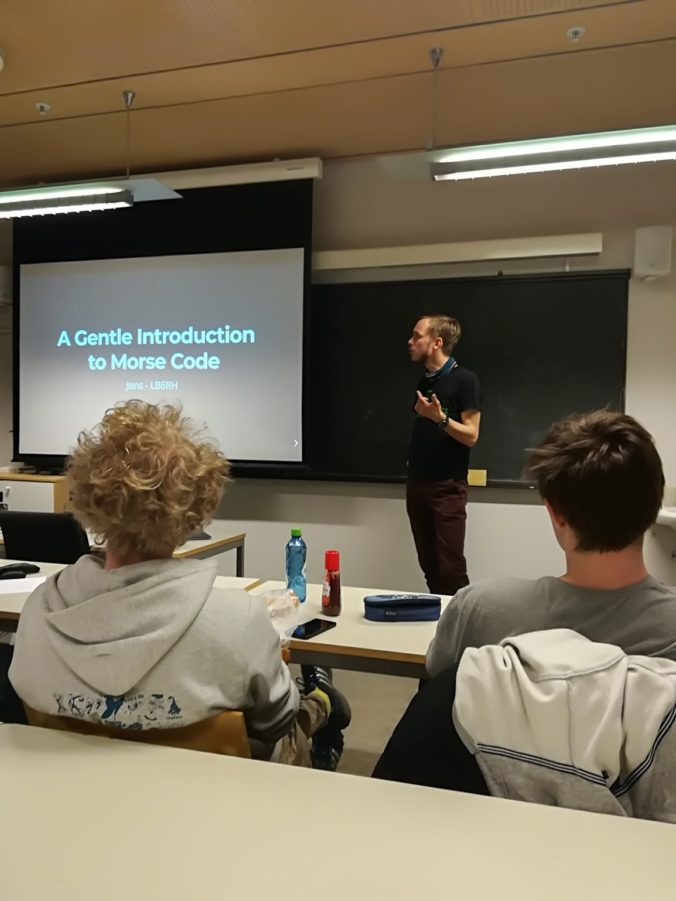Demonstrating knowledge of Morse code was previously a part of the amateur radio exam in Norway. Licensees would get either LA, LB or LC licenses based on their proficiency (or lack of proficiency) in this. After 2005, the requirement was removed, and all licenses granted since then were LA (and recently, LB) licenses, regardless of the skill level in Morse code. Subsequently, since learning Morse code no longer was a requirement for the “class A” license, the general proficiency in telegraphy among ARK’s member mass went down.
Still, there is some general interest in learning Morse. It is considered in ARK to be a nice skill to have, as it is a popular mode of operation, and there are contests both in Norway and abroad that consists only or partially of telegraphy. After the license course lecture on Wednesday 14.02.18, Jens – LB6RH therefore took the initiative to hold a brief session on the history of Morse code and how it can be learned.
This post summarizes the contents of that session, as a benefit to those wanting to learn Morse code for amateur radio.
Morse code was invented in the middle of 19th century, and was popularized through its use in the telegraph. With the advent of radio communications, Morse code continued to see use. For amateur radio enthusiasts, Morse code is still very popular. G7VJRs blogpost on the distribution of modes on the air, as recorded by Club Log, shows that between 1960 and 2013 around 40% of all amateur radio contacts were by Morse code.
Why is Morse code still so popular?
The signal processing between your ears is great – studies have shown that a trained operator is able to decode Morse code signals as low as 12-18 dB below the noise floor.
It is narrowband – The power needed to convey information is much lower compared to more wideband modes such as voice (SSB).
The hardware is simple – Single frequency transceivers can be yours for as little as 3$, such as the pixie kit that we used for our soldering course, more advanced stuff that is capable of around-the-world contact can be had for around 100$.
It is fun 😉
In order to quickly learn morse code there are some do’s and don’ts.
Do:
- Listen to morse code at full speed
Don’t:
- Start by learning how to send/key Morse code
- Visualize the letters with dots and dashes
The method is based on the Koch method, which was invented in the 1930s as a way to rapidly train telegraphists. The idea is that your brain should learn to decode by reflex. In order to do this, the student should exercise at a speed where the dots and dashes of adjacent letters blur into each other. This forces the brain to learn the rythm and sound of a letter, rather than translating from dots and dashes.
For this to be most effective, it is suggested that the student starts with only the two letters, K and M. Once those are 90 % successfully copied at 20-30 words per minute (WPM) for 2 minutes a third letter is added, and so on. The Koch method also specifies the sequence in which the letters should be learned.
There are multiple tools and applications that help you learn through the Koch method. Underneath are some tools for those who are learning (still learning the letters) and those who want to master (improve speed, retention and understanding).
Learning:
lcwo.net – Learn CW online (browser)
IZ2UUF Koch Trainer – Android App
Mastering:
qrq – Copy callsigns at high speeds
RufzXP – Copy callsigns at high speeds
MorseRunner – Contest/QSO simulation
ebook2cw – Listen to your favorite books in CW
—
In order to ease the process in the beginning, Farnsworth spacing may be added. This separates letters in groups with some spacing between each letter and each letter group. A typical group size is 5-7 letters, and a typical spacing is about as long as the group size.
With daily exercise it takes about 1-3 months to learn Morse code. We look forward to checking up the status of the course attendees in a couple of months’ time :-).


Leave a Reply